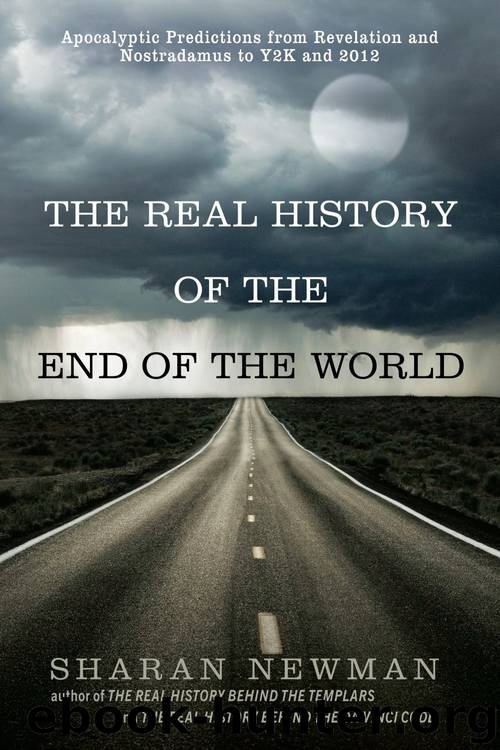The Real History of the End of the World by Sharan Newman

Author:Sharan Newman [Newman, Sharan]
Language: eng
Format: azw3, epub, mobi
ISBN: 9780425232538
Amazon: B0030CVRIY
Publisher: Penguin Group US
Published: 2010-11-21T18:30:00+00:00
CHAPTER TWENTY-FOUR
The Fifth Monarchy
We therefore freely, of a ready minde, and with a most chearful
heart . . . give up our lives and estates unto our Lord King Jesus,
and to his people, to become souldiers in the Lambs Army . . . ,
neither will we ever . . . sheath our swords again, untill Mount
Zion become the joy of the whole earth, . . . untill Rome be in
ashes, and Babylon become a hissing and a curse.
—A Door of Hope, Fifth Monarchy manifesto (1660), 16
Of all the millennial movements that littered the seventeenth century, the British Fifth Monarchy men were among the most paradoxical. They were not a religion; they were really not even an organization. They were more a unified belief system. And that belief was that they were destined to establish Christ’s kingdom on earth. Once they did this, they were certain that Jesus would descend from heaven bodily and take up the crown of Britain, from which base, his armies would conquer the forces of the Antichrist—that is, the pope, along with Catholic countries, and the Ottoman Empire.1
When Charles I became king of England in 1625, his prospects were good. He had a private income that allowed him to do much as he liked, and the English people seemed willing to let him, within limits. The limits were soon reached in two areas. The first was taxation without representation. Charles ran through his private income, apparently not realizing that wars are expensive. The king had the power of life and death over his subjects but not the right to take their money. Taxes had to be approved by Parliament.
Charles got around this at first by spending his own money and not convening Parliament. This worked from 1629 through 1640, until Charles needed an army to put down a Scottish rebellion. He was forced to call for parliamentary elections. The problem with this was that a lot of the members of the House of Commons agreed with the grievances of the Scots, who were refusing to swear allegiance to the Anglican Church. After three weeks, Charles dissolved this “Short Parliament.” The Long Parliament followed, but it wasn’t any better for Charles. Its members managed to pass laws that curtailed the king’s power, especially in levying new taxes and, most important, in controlling the army.
In January 1642, Parliament got fed up with Charles’ high-handedness and, in effect, fired the king. Charles went to Oxford, where he set up an “anti-parliament.” So the English Civil War was originally between the king and the Parliament. But soon Parliament became divided between the conservative Presbyterians who wanted to make peace with the king and the Independents (in religion), who wanted to be rid of him.2
This is where the Fifth Monarchy comes in. In 1648, the Long Parliament was taken over by a section of the Independents, who became the Rump Parliament. Many of its members were believers in the prophecy from the Book of Daniel (2:36-45) in which Daniel interprets Nebuchadnezzar’s dream to mean that there would be four kingdoms.
Download
The Real History of the End of the World by Sharan Newman.epub
The Real History of the End of the World by Sharan Newman.mobi
This site does not store any files on its server. We only index and link to content provided by other sites. Please contact the content providers to delete copyright contents if any and email us, we'll remove relevant links or contents immediately.
Becoming Supernatural by Dr. Joe Dispenza(8119)
Crystal Healing for Women by Mariah K. Lyons(7855)
The Witchcraft of Salem Village by Shirley Jackson(7188)
Inner Engineering: A Yogi's Guide to Joy by Sadhguru(6725)
The Four Agreements by Don Miguel Ruiz(6630)
The Power of Now: A Guide to Spiritual Enlightenment by Eckhart Tolle(5605)
Secrets of Antigravity Propulsion: Tesla, UFOs, and Classified Aerospace Technology by Ph.D. Paul A. Laviolette(5309)
The Wisdom of Sundays by Oprah Winfrey(5086)
Room 212 by Kate Stewart(5035)
Pale Blue Dot by Carl Sagan(4912)
Fear by Osho(4660)
The David Icke Guide to the Global Conspiracy (and how to end it) by David Icke(4625)
Animal Frequency by Melissa Alvarez(4395)
Rising Strong by Brene Brown(4377)
How to Change Your Mind by Michael Pollan(4292)
Sigil Witchery by Laura Tempest Zakroff(4180)
Real Magic by Dean Radin PhD(4073)
Man and His Symbols by Carl Gustav Jung(4067)
The Art of Happiness by The Dalai Lama(4063)
